After reviewing the expert interviews and many example team agreements, I found myself questioning exactly what the point was.
I’ve come to a better understanding and want to share the raw bones of it with you. And by raw, I mean chewy raw.
“I didn't have time to write a short letter, so I wrote a long one instead.”
―Mark Twain
Skim, read, digest, and please let me know what you think!
~ Elise
Team agreements document how, when, and where a team intends to collaborate. This practice helps teams avoid problems that crop up when individuals choose to work in incompatible ways.
During the interviews, Lisette Sutherland said:
"I started talking about this more than a decade ago and still at every presentation, every workshop that I give, less than 10% of any audience has any kind of team agreement in place"
This gave me pause. Why don't more teams create these agreements? Are they perhaps not as useful as I thought? Is this an idea that sounds good in theory but fails in practice?
I don't believe so.
My years of direct experience tell me this practice is highly beneficial, especially for distributed teams. I believe the reason these agreements are still relatively rare has more to do with the changing nature of work than their efficacy.
To understand when a team agreement is useful and why they're more common in some settings, let's step back and consider its role. We'll take a sweeping peek at how people learn to work in teams, the causes of collaborative drift, and the mechanisms organizations use to repair drift and overcome compounded collaborative debt.
Spoiler: Team agreements are part of the answer, but they’re not right for everyone.
In This Article
The Essentials: Figuring Out How to Work Together
Are you a knowledge worker? If so, when you need to figure out how to get a job done, you have so many options!
As a simple example, let's take this article. I had options! I could draft it in one of hundreds of editors and publish it on any one of a dozen platforms. So, I researched my options, tried some things out, and did my best when my skills fell flat.

Individuals research, experiment, innovate and cope
When we work together, however, my choices must harmonize with the rest of my team. I can't write articles where only I can access them if my colleague needs to add images. I can't take as much time as I want when someone needs the article for tomorrow’s marketing campaign.
This requires us to figure out not only how to do our job, but also how our job is done with our team.
We learn how to work together in several ways.
Tacit Understandings Emerge
Our first and most natural method is to look around to see what everyone's doing and then do that. When in doubt, we may ask someone, and we always keep our ears open for important gossip.
This tacit understanding emerges through observation and conversation.
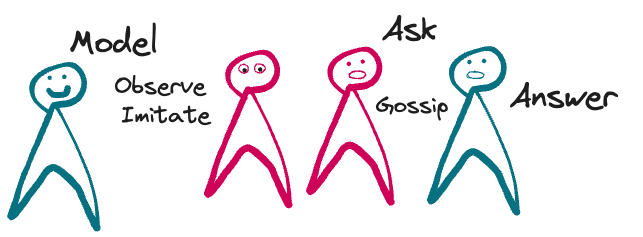
Emergent learning through Observation, Imitation, and Conversation
While gossip has a negative connotation, it serves a crucial function in helping people learn how things really work. Gossip can teach you who you can rely on for support, who to approach with caution, and the stories explaining why things are the way they are.
Sometimes, when the goals are clear, the timeline short, and your team is in frequent contact, that's all you need!

You just need a tacit understanding to collaborate on short, simple projects.
We all have experience with emergent teaming—this is how we team up on the playground and how we launch quick, exciting new projects. It's fun, it's exciting, and all too brief.
On LinkedIn recently, Helene Jewell described how great this kind of teaming feels.
What's your experience?
When were you part of a team that came together and just figured it out as you went? How cool is that?!
Until it isn't.
When the project takes longer and requires a journey through obstacles unknown, we need more support.

Wow. Not sure how we’ll get there…
Collaborate to Create Explicit Plans & Agreements
To figure out how we'll climb the mountains, cross the seas, and find our way, we make plans. Plans outline who will do what and by when. Then, team agreements document how we'll execute those plans, listing the tools we'll use, our expected communication methods, and more. A cadence of rituals evolves our plans and agreements, reminds us of our values, and reinforces our desired culture.

Teams collaborate to make plans and agreements explicit
Collaborative learning leads to explicit agreements that evolve with the team and the context. Useful plans, rituals, and agreements are always open for review and regularly updated as the situation changes.
This is the most unnatural form of group learning. It requires System 2 analytical thinking, creativity, grit, adaptability, and a detail-orientation approach paired with a non-attachment to the details. There are plenty of folks who neither enjoy nor excel in these skills, which makes them a poor fit for collaborative teamwork.
That doesn't mean that other types of teams rely solely on observation and gossip to learn their jobs, though. The third way we learn to work together is through training.
We Train on Organizational Mandates

Organizations train team members in the mandated ways of working
Training ensures that everyone knows their team's key constraints, such as legal, safety, and HR policies, and possesses adequate proficiency in required skills. Beyond training, these high-level mandates involve extensive communication, auditing, and reporting requirements. Rolling out and maintaining mandates takes a lot of effort, so organizations try not to change them often.
Put them together, and we can figure out how we work together in three fundamental ways.

How teams learn to work together: A) Tacit understanding emerges, B) Explicit agreements and plans evolve through a cadence of collaborative rituals, and C) Teams adhere to executive and government-mandated rules.
What do these systems look like in your experience?
I've drawn the boundaries between these ways of learning with broken lines because, in reality, they blend and overlap
Learning Spans All Levels
Here’s a quick example. When I work with an organization to improve its decision-making, we aim to span these systems.
Mandates: the organization decides which decision-making processes everyone should use and trains people on them. They also establish high-level mandates around some decisions, such as those that require board approval or a significant budget.
Explicit Agreements: Teams and departments agree on how they will make specific decisions together, and which decisions individuals can make on their own. The team documents this in a Decision Matrix. When they make decisions, they log them to create transparency, accountability, and future reference.
Tacit Emergence: Within these guidelines, individuals interpret and implement the decisions. When facing a new decision, individuals evaluate whether they can make it on their own, or whether they'll get the team involved using one of the documented processes.
These systems adapt over time. Teams might find that they're spending too much time making decisions together, so they'll loosen their agreements and entrust more decisions to individuals. Or, they may find that individuals are making too many risky decisions so they make the process more explicit. When your organization uses all three learning approaches, you can shift and adapt as your needs evolve.
The ability to tune your learning approach is critical for healthy collaboration because drift happens.
Collaborative Drift's Drag on Team Health
Even though we have all these ways of figuring out how to work together, we remain individuals looking at the world from our unique windows, doing the best that we can.
Often, we act in ways that nicely complement each other. But not always.
When two team members think and act in non-compatible ways, you get collaborative drift.
Collaborative Drift: the minor confusions, bad feelings, and inefficiencies between team members that arise when individual members' actions and assumptions diverge.
Collaborative drift is unavoidable, tricksy stuff. There your team goes, flying down the road. You take your eyes off the collaborative wheel for just a moment, only to find you're drifting into the gutter. You didn't even do anything!
This is how it happens: collaborative drift often arises more from inaction than from conflict.
Sources of Collaborative Drift
Here are some of the more common causes of collaborative drift.
Misalignment Creates Drift
Sometimes team members come to different conclusions.
While misalignment can create conflict, it doesn't always signal an active disagreement or even any attachment to the idea. Misalignment can occur whenever there is a lack of clarity or misunderstanding.
For example: let's say a new leadership team agrees to respect everyone's time and input.
Sally believes this means including everyone in every meeting, while Betty thinks it allows her to control her own schedule. Sally and Betty both become frustrated when Sally invites Betty to meetings that Betty declines.
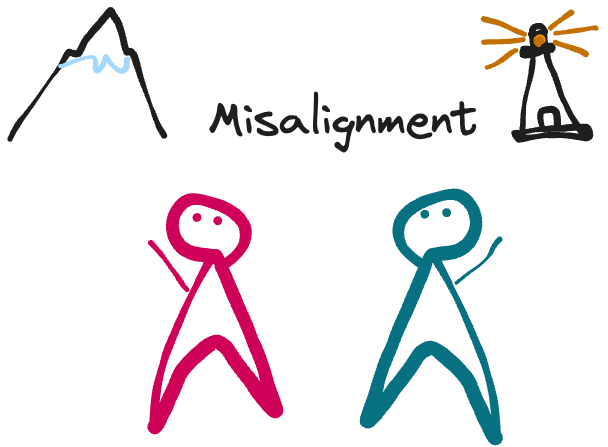
Drift Happens When We Make Bad Assumptions
It's neither useful nor feasible to spell out every detail in advance, so teams figure some things out as they go.
Assumptions creep in.
Let's say Sally agreed to schedule the team's meetings, but the team never discussed who would update the agenda in advance. Sally assumes everyone will add their own updates, and gets frustrated when no one does. Everyone else assumes Sally will take care of it as part of her scheduling role, and they're frustrated by the poorly planned meeting.
Unlike misalignment, where people form different opinions and interpretations about things they've discussed, bad assumptions form when we don't talk about things.
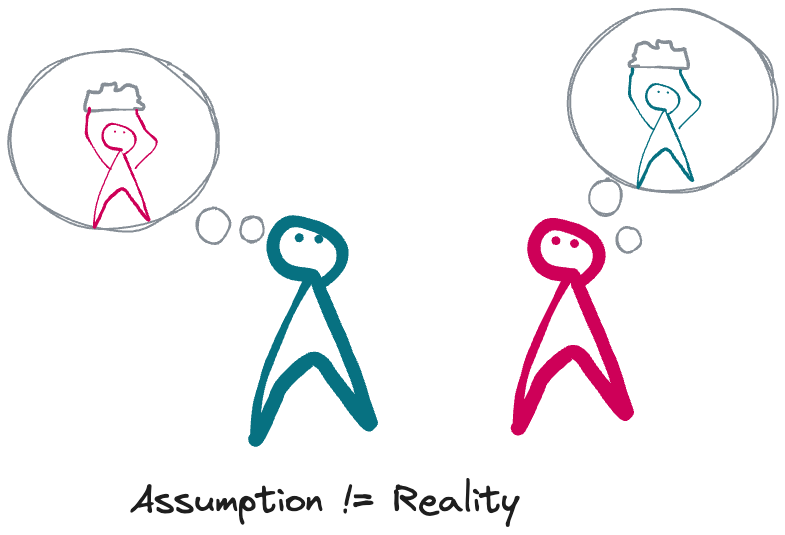
Drift Away When You Don’t Ask for Help
Imagine Betty gets stuck on a difficult task but doesn't ask her team for help. Days pass, the deadline nears, and she's still blocked. Meanwhile, others are waiting for Betty's contributions. They fret, diverting energy and attention away from their work towards worrying about "what's up with Betty."
Eventually, Betty either delivers or calls for aid, but not before doubt about Betty's reliability creeps in. The drift arrives, eating at the team's confidence.

Acting Without Communicating Creates Drift
The group decided to create products for the competitive crochet industry, so Sally scheduled a meeting with Awesome Yarns. Unfortunately, she didn't tell her team about it. If she had, they could have warned her that Betty is close personal friends with the CEO of Yarns-R-Us, Awesome Yarn's key rival.
Because Sally acted without communicating, her team had to scramble, rework their plans, and rescue their relationship with Yarns-R-Us.
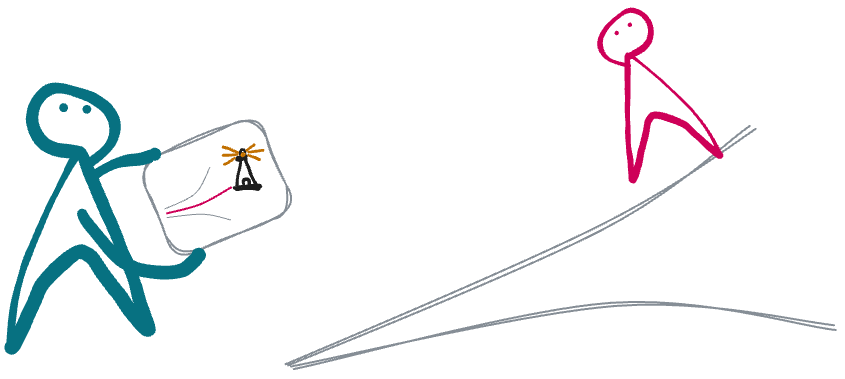
You get the idea. In these and many other subtle ways, we've all experienced a time when our expectations didn't match reality, and we felt a crack in our team cohesion.

Drift cracks collaborative teams.
Minor Drift? No Big Deal
Teams assigned to short projects with clear deliverables can ignore collaborative drift. Little cracks along the way are easy to hop over.
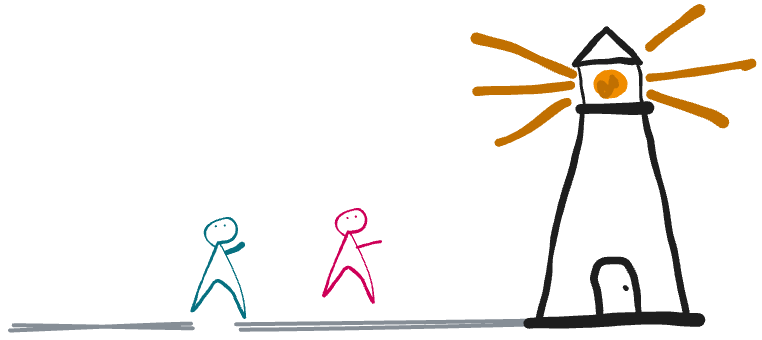
Even when you find yourself drifting off the road on more complex projects, it's pretty easy to correct course when you catch it quickly. Refocus, steer away from the ledge, and you're back on track
When we collaborate in person, some drift correction happens automatically. We can literally see and hear when our team members drift, and then step in to help.

You can also correct for invisible drift – the drift that happens when teams misunderstand each other or make assumptions that turn out to be wrong – by talking about it. As Lisette said:
"I have a lot of teams saying we don't need (Team Agreements). So they'll say, we're, you know, we're a close-knit team. We've worked together forever. We know how each other works."
They’re describing a way of working that emerged over a long time.
Put it together, and you can recognize that collaborative drift happens on every project, but you don't have to worry much about it when:
The project is short so you can just push through to your goal.
You have a stable team that likes to talk, faith that key relationships will hold when disagreements arise, and an ample budget for the communication overhead
What you're doing isn't that important to you.
(OK, drift may still break the team, but maybe you don't care?)
In these situations, the systems teams use to figure out how they'll work look like this

Teams follow plans, most of which are mandated by leadership. These plans still adapt to changing circumstances, but more slowly.
That's a good thing! It doesn’t make sense to change your mind about the crop you'll plant at harvest time, and you shouldn't redesign your grocery store every quarter. When plans change slowly, teams have time to figure out "how things really work around here" through observations and the shadowy network of peer-to-peer conversations.
Working this way feels natural. Based on the name, you might assign nefarious intent to the shadow network. In reality, though, what we often do in the shadows is get shiznit done.
Repairing Drift with Rituals and Team Agreements
Historically, most teams worked together in one place on real-world visible tasks, where a mix of tacit and mandated learning does the trick. Many teams still do.
The rise of the managerial class and the knowledge economy changed that. Collaborative teams developing software or leading organizations do a lot of work in their heads, so they can no longer glance over to check if they're drifting apart. The plans and priorities change quickly, too.
Because there isn't a great way to determine the capacity of a knowledge-working team, they're assigned optimistic rooms full of hay to spin into gold. They needed new ways to wrangle all that hay into sensible shape, and a strategy for discovering invisible drift, so they developed new Rituals.
Agile standups, leadership daily huddles, and even McChrystal's famous O&I briefing are examples of high-frequency rituals that identify and repair collaborative drift.
Rituals like daily check-ins aren't busy work. They're the regular exercise and preventative maintenance that keep a team fit.
Bud echoed this in his interview when he said:
We focus a lot on rituals, because I fundamentally believe rituals will hold you and make up for a lot of other shortcomings. (...)
It seems so obvious, but it's so important, especially the world we live in now, to have time just for collaboration.
Where Team Agreements Fit & Why They’re So Rare
Team agreements sit between the plans and the rituals. They spell out how, where, and when teams will work together. Agreements evolve, but more slowly than plans, and usually in response to collaborative drift. When the team identifies a new source of drift, they update the agreement to repair the drift and prevent a re-occurrence.
Returning to that earlier example, when the team realizes that Sally talked to Awesome Yarns without letting them know and now they're in a pickle with Yarns-R-Us, they could just tacitly agree on how to handle the situation, which solves the problem for the moment. They could also update their team agreement to include something like "We track who we're working with and any important conflicts in our CRM. Check the CRM before making an appointment," or "Send a note in Slack before making offers to new clients so we can check for conflicts and share what we know about them."
If they document an explicit agreement, new team members can read it to understand how to engage new clients. They don't need to guess or ask around or wait for it to become clear over time. They won't repeat Sally's mistake. They can look it up. Awesome! We're good at that.
Remember - this is how we figure out things on our own.

Research: that includes looking stuff up!
With a documented agreement, folks can check it whenever they have a question about "how do I do this here?" Pretty handy! In this way, team agreements act as a single source of truth where the team can manage and prevent collaborative drift.
So why do "less than 10%" of the folks who seek Lisette's help have any kind of team agreement?
I think it's because most teams work together in an office where it's easier to ask your neighbor or see when Sally is getting excited about her upcoming meeting. On site, you're surrounded by the shadow network. Historically most teams could get by without a team agreement.
On remote teams, however, you have no idea what other people are doing until they show you.
Team agreements are useful for every team, but they're a necessity for large all-remote teams because these folks can't easily observe, imitate, or gossip their way to clarity.
So for Lisette, beyond the selection bias (as in, folks who know how to collaborate well in remote teams don't call her), she doesn't see more teams with agreements because distributed teams are a relatively novel way of working.
The all-remote learning mix looks more like this.

Explicit agreements take prominence when in-person emergence isn’t possible.
Before the pandemic, you could count the number of big all-remote companies on your fingers. That number is rising, but it's still nowhere near as many teams as those operating on site or in hybrid settings.
As a data point, the latest report from WFHResearch says that 13% of surveyed U.S. full-time employees were fully remote, 62% were full-time on site, and 26% were in a hybrid arrangement. Their data doesn't encompass the entire workforce, as folks who aren't on computers much aren't included. Also, that 13% of the workforce includes lots of folks working independently rather than as part of a team. This leaves us with less than 13% of the workforce that lacks easy access to the shadow network. Sounds to me like Lisette is doing pretty well!
Problem: The Shadow System is Unpredictable
Collaborative remote teams are more likely to use team agreements because they can't easily access the shadow system.
This doesn't mean that the shadow system is a better choice for on site and hybrid teams.
On the contrary, for every story about a great team that loves each other and works well because they've "known each other forever," you have hundreds of stories about teams that devolved into backstabbing, petty feuds, and rampant dysfunction. Sometimes when you ask a colleague how things work, you get the answer you need. Other times, you get the story about how awful the assistant is and how lazy another co-worker is and how management is clueless.
While you can observe and talk your way back on track, it's more likely that when you rely on the shadow system, collaborative drift will go unaddressed.
And that crap multiplies.
Untreated Drift Becomes Collaborative Debt
Unaddressed collaborative drift compounds.
Take the example of misalignment.
Let's imagine our example CEO declares that the team will win the competitive crochet market with a strong presence at the next Crochet Olympics. Sally, the head of marketing, believes this means corporate sponsorship and a speech. Betty, the product lead, believes this means going to the Olympics to interview crocheters about their needs. Sally and Betty don't discuss their different interpretations. Instead, they begin to act.
Betty schedules interviews with crocheters attending the Olympics. Sally invests in banners and swag, eating up the budget. When Betty tries to book flights for her team, she finds just enough budget for two people, so she books herself and her research assistant. Then, when Sally tries to book her ticket as the company spokesperson, the funds are gone. Both Sally and Betty are deeply frustrated about the other's misuse of the budget and disregard for what they saw as a clear mandate from the CEO. Now, instead of a unified leadership team, they've become two rivals representing different silos within the company, sparking years of petty conflict between departments.
Sound familiar? That's Collaborative Debt.
Collaborative Debt: the accumulated impact of unresolved collaborative drift, leading to dysfunctional team relationships and inefficient coping mechanisms.
Collaborative Debt accrues when we fail to notice and repair the drift introduced by misalignment, false assumptions, and unexpected actions. Like its siblings, technical debt and conflict debt, it can make sense to take on some collaborative debt when you're in reach of your goal. After all, it takes time to surface and repair drift, and that's not always time best spent.
But - just like technical debt and conflict debt and financial debt - if you continually rack up more debt without paying it down, you'll soon find that the gaps between team members have grown too wide. Trust is broken, and without it, you can't move forward.
When this happens, teams do one of three things.
High Collaborative Debt Leads to More Meetings, More Bureaucracy, or Culture Repair
If you work in an organization that suffers from too many meetings or where you have to jump through a series of bureaucratic hoops to get anything done, it means that the value your organization is meant to deliver and the systems you use to deliver that value are not aligned. The way you work does not match the work you need to do.
This is what happens when the drift that started with a simple lack of clarity turned into a leadership team schism and then escalated into departmental silos that now only communicate through forms and a five-step approval process.
People interacting through forms don't have to like or trust one another. They can ignore collaborative debt because they're no longer collaborating.
Bureaucracy is a symptom of broken trust and collaborative debt left unpaid.
Collaborative debt builds when leaders reorganize everyone or kick off new change programs every few months, leaving teams no time to form explicit agreements. Since everything's in flux, no one can write down how they work, so you can't look it up or ask someone more experienced.
This organizational churn forces everyone to meet with everyone else to figure out who's doing what, who can make the next decision, and exactly where the cheese is hiding today. If you talk with enough people you can push projects forward, but all that meeting time eats away at the schedule, so it's damn slow going.
Meeting overload is a symptom of unpredictable leadership, unreliable management, and collaborative debt left unpaid.
You can use lots of meetings or lots of BS forms to cross the chasms created by collaborative debt, but if you do, you will never become a high-performing, adaptive organization.
For that, you must pay down your debt and repair your broken team culture.
Remedy: Adding Team Agreements in High-Collaborative Debt Environments
Every expert I've interviewed, including myself, has encountered teams that we tried to help but failed.
We are imperfect, so some of those failures surely fall at our feet. More often, though, the team fails because this work can hurt. Just like it’s no fun to slave away to pay off a credit card debt, it's no fun working extra hard to unwind bureaucratic nonsense. No one gets a special company award or a big bonus for solving problems that everyone was pretending not to notice. Resolving collaborative debt requires time, effort, and uncomfortable sacrifice.
As Bud said:
"We always tell clients that it will get worse before it gets better."
Gustavo emphasized this challenge, saying:
"If someone doesn't quit in the next few weeks or so, then we didn't do our job."
That’s hard! And now, I hope you can see why that might be.
When you decide to establish rituals, a team agreement, and other healthy collaborative habits, you will shine a light on all the ways your team has drifted apart over time. Some of these cracks are too wide to repair, which means some team members may break away.
That hurts, especially when the team has been together for a long time. It creates a gap that must be filled and a loss that must be mourned (even when it's also a huge relief!). As collaboration consultants, we've all worked with clients who prefer their meetings and bureaucracy to the painful process of paying down the debt.
And yet, teams that persevere come out stronger. They fix the friction dragging at them, speed up, and rediscover the joy of creatively collaborating again.
Example: A Team After Collaborative Rehab
A leadership team I worked with spent four grueling months grinding through years of collaborative debt. By the end of that time, they'd established new agreements and rituals that reduced their meeting time by 40% and increased their on-time project completion rate by 100%. They continued to refine their agreements and within a year, their seasonal turnover rate dropped from 60% to 12%.
They said:
"Everyone is active and engaged in the meetings and contributing. It has brought our team together and we are seeing results even outside our meetings."
"I saw (my peers) completely change how they manage their staff. They created an honest-to-goodness culture with the seasonal workers - we've never had anything like it! And they're loving it."
"I feel that we are all closer and work together better. We get things done! Being in separate departments it can be challenging to come together.
Like Bud said, things got harder before they got easier, and then teamwork became much, much easier.
Conclusions and Questions for You and Your Team
Alright, let’s wrap this up. In conclusion...
Teams rely on three main systems to figure out how to work together: a shadowy, informal system where tacit understandings emerge, explicit agreements that evolve, and training on mandates that change infrequently.
Question 1: How do folks learn on your team?
Collaboration involves deciding between dozens of ways to approach largely invisible work. When team members make incompatible choices, either due to misalignment, bad assumptions, or poor communication, it creates collaborative drift. Drift creates collaborative obstacles the team can push through, repair, or ignore.
Pushing through is appropriate on short, clear projects. Repair may happen naturally or through the use of team rituals and agreements. Drift that is ignored compounds into collaborative debt over time.
Question 2: How does your team handle collaborative drift? Do excessive meetings or bureaucracy indicate unpaid collaborative debt in your team?
New collaborative teams can reduce the risk of accumulating debt by establishing team agreements from the start. This is common practice for distributed teams at all-remote companies like GitHub, Atlassian, and more. It's also common practice in flatter organizations that embrace self-managed teams and distributed decision-making.
Teams that have been together for some time can also create new team agreements. Creating new team agreements will uncover existing debt that needs to be addressed. The changes that come will take time to implement and may drive some team members to leave.
Question 3: How much collaborative debt does your team have? What would make sense for you to do next?
I'd love your thoughts and feedback.
Did you find these articles useful? Know someone else who might enjoy it?
Please forward, share, subscribe, and help us spread the word. Thank you!
The New Rules for Work Labs is hosted by Lucid Teams.
Learn more about our work with organizations at: lucidteams.com
